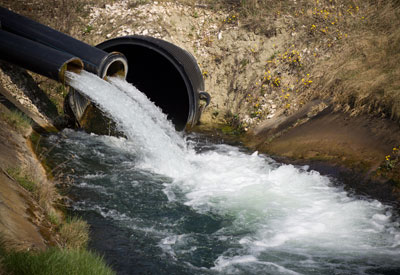Reducing your Facility’s Phosphorus Loading
Water must be clean and healthy to sustain aquatic life and provide recreational use. Although phosphorus is a nutrient for plant growth, excess phosphorus can speed up the aging process of lakes and streams by over stimulating algae growth. Algae blooms are unsightly and create high biochemical oxygen demand (BOD) as the algae decomposes and uses up available oxygen supplies, sometimes threatening the survival of fish and other aquatic organisms.
During high rainfall periods, the majority of phosphorus loading comes from non-point (non-specific wide-spread) sources caused by significant runoff from agricultural lands. The Minnesota Pollution Control Agency’s (MPCA) monitoring data has documented during these high flow periods that only 10% of total phosphorus comes from point sources.
Point sources contribute as much as 64% of total phosphorus to Surface waters during low flow or low rainfall conditions. These point sources include wastewater treatment plants and industrial dischargers. Industrial sources of phosphorus include food processing, phosphatizing, and cleaning operations.
Public wastewater treatment facilities (WWTF) that have or anticipate phosphorus effluent limits are turning to their commercial and industrial users to reduce the volume of phosphorus in sewered wastewater. Facilities need to first identify and then reduce sources of phosphorus in your facility in order to limit the amount of phosphorus discharged to the treatment facility. Point source phosphorus reduction can help the WWTF minimize the amount of chemicals needed to treat the phosphorus before discharging to lakes and streams.
Identify and Reduce Sources of Phosphorus
Many kinds of businesses are likely to contribute phosphorus to the WWTF. These can include agricultural co-ops, car/truck washing facilities, dairies, food processing plants, meat packing plants and lockers, metal finishing facilities, municipal water treatment plants that add phosphorus to drinking water, nursing homes, restaurants, schools, and other institutions. Additionally, industrial cleaning and sanitizing operations in any facility may result in high discharge levels of phosphorus. The MnTAP fact sheet, Phosphorus: Reducing Releases from Industrial Cleaning and Sanitizing Operations addresses this concern and provides information about alternatives.
Identifying what processes contain phosphorus is a good place to start. Once those have been identified, you may be able to talk to your chemical supplier to discuss alternatives that either contain low levels or no phosphorus at all. MnTAP has helped several facilities reduce their phosphorus. Examples are found in the following section.
Wastewater treatment facilities should develop a Phosphorus Management Plan. MnTAP and the Minnesota Pollution Control Agency (MPCA) jointly developed the Phosphorus Management Plan Guide (2006) to help WWTFs develop their management and reduction plans. The guide outlines steps to work with local businesses.
Process-Specific Fact Sheets and Case Studies
These fact sheets and case studies provide information about specific processes and facilities with high levels of phosphorus, like metal phosphatizing and food processing operations that typically generate high levels of phosphorus in wastewater.
Fact Sheets
- Metal Finishing: Metal Phosphatizing Operations (2009). Information on processes that result in high levels of phosphorus discharge and examples of alternatives including equipment, chemicals, and treatment options.
- Food Processing: Phosphorus: Reducing Releases from Dairy Processing Facilities (2009) and Phosphorus: Reducing Releases from Meat Packing Operations (2008). In dairy and meat packing operations, cleaning production lines, scraping food preparation vats, cleaning and rinsing equipment, and rinsing product and floor cleaning chemicals down the drain are all ways phosphorus enters wastewater.
- Food Processing: Phosphorus: Reducing Releases from Poultry Processing Plants (2008). Steps that can be taken to reduce phosphorus discharge from poultry processing plants.
- Other: Reducing Phosphorus on University & College Campuses (2009). Ways to assess and reduce phosphorus use in various campus departments.
Case Studies
- Coating Process: Minnesota Elevator Benefits from Switch to a New Coating System (2010). MEI evaluated alternatives to the iron phosphatizing chemical and switched to zirconium oxide (nano-ceramic) conversion coating, which is phosphate free, used at ambient temperatures, and does not require a seal rinse.
- Coating Process: Intern at Artic Cat Reduces Water, Energy, and Chemical Use (2009). The company reduced their phosphorus concentration in the iron phosphate stage by limiting chemical additions to the system and using just the chemical that was already in the tank.
- Food Processing: Sunny Fresh Foods pg4 (2006). This food processor worked with its cleaning and sanitizing vendors to reduce its phosphorus effluent by 80%.
- Other Manufacturing: Ver-tech Labs Reduces Phosphorus in Wastewater Discharge (2008). The facility engaged employees and worked with the City of Rockford to reduce phosphorus in wastewater.
- Other Manufacturing: Electrolux Reduces Phosphorus 86% (2005). Electrolux converted the wash stage on its two paint systems to non-phosphorus chemical cleaners and sealant solutions to reduce the phosphorus going to its WWTF.
